Online dating apps like Tinder or Bumble are getting you to the top of the funnel with your ideal partner.
It’s all fun and games. There’s no commitment. Just seeing what’s out there. Your info can be seen too, but unless your profile catches someone’s eye, they’ll be swiping to the next person.
Top of funnel content is the very beginning stages of the relationship between your brand and your target audience.
Not every swipe ends in a date (or an email subscriber). The funnel gets smaller.
Not every person you date ends in a proposal (or an add to cart). Your funnel loses a few more people.
Not every proposal ends with a wedding (or a purchase)...you get the point.
Growing your business takes the same steps as growing a personal relationship.
So what exactly are the different stages of a buyer’s journey in the marketing funnel?
- TOFU or Top of Funnel
- MOFU or Middle of Funnel
- BOFU or Bottom of Funnel
A good content marketing strategy can help your company get in front of people at each stage and move potential customers to the bottom of the funnel sooner, which puts more money into your pocket.
While every part of the funnel is important, we’re going to dive into why you should include top of funnel content into your marketing strategy. By focusing on strengthening that relationship with your target audience up front, it can help improve metrics around getting new leads, increasing conversion rates, and improving retention of those potential new customers.
Get brand new marketing strategies straight to your inbox. 23,739 people already are!
What Is Top Of Funnel (TOFU) Marketing?
Top of funnel marketing is referring to potential customers who are at the beginning of the buyer’s journey, often called the awareness stage. They are in the informational gathering and researching phase of decision making.
Most companies focus their PPC, Facebook Ads, and SEO efforts solely on the bottom of the marketing funnel because those people turn into customers the fastest. But, by creating top-of-the-funnel content you can improve the ROI of all your other marketing channels. This is what makes content marketing campaigns, which reside at the top of the funnel, so powerful.
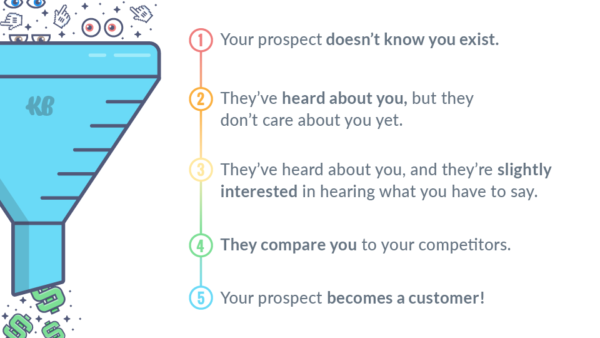
10 Benefits Of Top Of Funnel Marketing
1. Owning The Conversation & Being On The Same Page
Some clients ask me, “Why should we bother writing about these topics, they are so basic and not our ideal customer.”
The answer I give is that all customers start off with questions at some point.
Even if they are not an ideal customer now, if your company starts educating them on terminology and your processes through blog posts and emails, you can establish a solid foundation.
2. Brand Awareness & Being Top Of Mind
A brand that educates and adds value consistently will become the default place potential customers will go to when they have questions.
A quality content strategy can cement your brand at the top of the mind of potential future customers so when they are ready to hire somebody you will be the first person they contact.
Your sales people will have to do less work because your content did it all for them.
3. Building Trust
With every quality piece of content that you put out, you are building trust with new members of your audience who are at the beginning of their journey of finding a solution to their problem.
Consistently adding value to people builds trust in your brand and establishes your company as an expert in the space that can keep you top of mind for years.
But, just because you’re top of mind, it doesn’t always mean it’s a good thing. We have all had bad experiences that make us not want to ever work with a company again. (If you’ve ever had food poisoning from a restaurant, you know exactly what I’m talking about.)
As long as you’re always getting consent to email subscribers or not overloading them with Facebook ads, the trust will always be growing.
4. The Evergreen Snowball Effect
One of the greatest parts of content marketing is that it is evergreen, meaning that it will add value for years to come.
Everyday people wake up trying to find solutions to problems that your company solves.
You are probably familiar with Frequently Asked Question (FAQs) pages that have a list of the most common questions that they are often asked by their customers along with a quick answer.
These FAQ pages can be a great outline for the top of funnel pages that your company should create because oftentimes a customer’s questions cannot be answered in just a couple of sentences.
For questions that you get asked repeatedly should get its own dedicated page to fully answer that question. Having an entire page allows you to optimize the page to rank as a solution to that question and fully explain it to new customers.
As you create quality content consistently over time they can start to rank organically for these common questions. We call this the snowball effect because overtime this content gains momentum and eventually becomes an avalanche of new visitors and potential customers.
5. Low Competition
As we mentioned before, most companies only focus on the bottom of the marketing funnel.
This is what makes search engine optimization (SEO) really difficult for newer companies because they need to catch up against the competition who have been doing it for years.
By focusing on the top stage of the marketing funnel topics you are usually competing with websites like Quora or Wikipedia that Google uses to fill in gaps in search results. This low competition is a good opportunity for a company to come along with great answers to overtake these types of sites that are generalists.
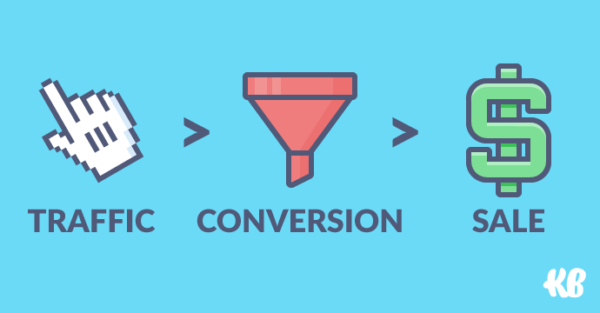
6. It’s A Fast Pass For Customers
Have you ever been to a busy amusement park like Disney World or Six Flags? The lines are so long that you end up waiting for hours to get on the latest ride that lasts less than a few minutes. Such a bummer.
But then an amazing invention came around called the Fast Pass. These fast passes allow you to skip the mainline and go into another much shorter queue. This can turn a three-hour ride line into a much shorter fifteen-minute line which makes people really happy.
A well-crafted piece of content can do something similar for your potential customers. It helps them jump from the research phase directly to signing up for a demo or purchase.
This is amazing because you actually are turning them into customers before they even attempt a bottom-of-funnel search. You just got them to bypass the tough competition at the bottom of the marketing funnel and become a customer.
7. Create Assets For Your Sales Team
Your sales team’s time is extremely valuable. They have their own sales funnel to worry about.
The less that they have to create or explain, the less selling they have to do. Saving the time of your sales team is going to decrease the time it takes to convert a lead and therefore bring you even more ROI.
All the content that you’re creating for the top of the marketing funnel are assets that your sales team can link to.
Having a one-pager available to them with quick answers to common questions along with links to your quality top of funnel content will also help your sales team to give consistent answers.
8. Improves Your Email Marketing
When somebody comes to your blog post through a top of funnel piece of digital marketing they are usually not ready to jump into purchasing OR scheduling a demo.
We don’t want to lose the opportunity to add value or reconnect with this potential customer so having some kind of email capture like an ebook or cheat sheet is a great way to grow your email list.
Having a content strategy paired with an email capture and digital marketing strategy is an incredibly powerful passive way to keep your sales funnel full of potential customers.
9. Improves Retargeting Marketing
Lastly, if you are getting a lot of traffic from organic to your blog, even if they do not convert or give an email, you are still able to get value.
By potential customers visiting your website you are able to pixel them and start retargeting.
With smart retargeting campaigns, you can easily get them to come back and become a customer.
In 2018, 41% of shoppers abandoned a transaction at a virtual check-out. They went all the way through the process to check out and abandoned it at the last second.
A simple retargeting campaign in your digital marketing could bring a large chunk of that 41% right back to their cart and finish checking out.
10. Creating demand with out-market buyers in advance of purchase
The truth: while in-market buyers are actively seeking solutions to problem you solve, they make up only 5% of the market.
That means that at any given time, 95% of your potential buyers are sitting out-market, without a need or means to act at the moment.
When you only market to the bottom of the funnel (in-market buyers), it's like competing for the last-minute attention of a tiny pool of buyers who know nothing about you. Sorry, but by then, it's already too late.
Top Of Funnel Measurement and Metrics
In order to measure success for anything in your business, you need to start with a goal.
The goal for a top of funnel content campaign is to get as many new visitors as possible & push them down to the middle or bottom of the funnel. So any progression down the marketing funnel from the top is a win.
For blog posts, we usually have at least two goals at KlientBoost for our clients: a fast lane and a slow lane.
1. Fast Lane Goal
A fast-lane goal is how the company makes its money.
Examples of fast lane goals
- Product sales & revenue
- Free trials/demo sign-ups
Having someone land on your blog and then turn into a customer is a huge win.
Most of the time someone who is in the awareness phase is not ready to jump into buying what the company is offering, they are still in the courting phase.
Measuring Fast Lane Goals
Since these are the same priority goals for the entire company, you want to measure the completions coming from your blog and top of funnel resources only.
What to measure:
- Organic traffic
- Revenue
- Sales Qualified Leads (SQL) & Marketing Qualified Leads (MQL)
2. Slow Lane Goal
A slow lane goal is any other goal that helps you to re-engage or move a potential customer down the sales funnel.
Examples of slow lane goals
- Email captures
- Engagements with a chatbot
- Pixel for retargeting
- Increase in social follows
Measuring Slow Lane Goals
The way to measure your slow lane goals is to track the key performance indicators of those marketing channels.
For example, if you have an email capture and drip campaign, you want to see if the rate of emails gathered is increasing and if they are turning into customers. The same goes for chatbots, organic traffic, or any other slow lane goal.
Top of Funnel Marketing Strategies
Make Sure To Have A Compelling Call-To-Action
When somebody comes to your website they might not know who you are or what you do. To help guide these visitors on what to do next, you need to have Call-to-Actions (CTA’s) so they can opt into the fast lane or slow lanes that you have set up.
Did you know that 96.7% of people will leave your site or app without buying anything? If there’s no obvious next step they may leave, forget who you are, and never come back. Having a call to action that somebody can’t help but click, helps you to build a relationship with these potential customers.
Implement An Email Capture
Most of the time when people are in the information-gathering phase of the customer journey they are not ready to jump into a sale or an hour-long demo with a salesperson. They are still trying to figure things out.
Instead of only offering call-to-actions that try to get visitors to “Buy Now” or “Sign Up For A Free Demo,” it’s important to add call-to-actions that allow you to be able to continue to reach out to them directly and help them along their customer journey.
A powerful way to communicate with potential customers is through email. By offering something of value in exchange for their email will allow you to educate and warm them up to be a strong customer in the future.
Examples of email list building assets
- Ebooks / Guides
- Reports / Infographics
- Quizzes / Surveys
- Calculators / Tools
- Checklists
- Case Studies
- White papers
- Webinars
Increase Your Social Media Channel Followings
The more followers your social media channels have, the more opportunity you have to stay top of mind as they see your posts while cruising through their news feed.
For example, 97% of B2B marketers use LinkedIn as a content distribution network.
How to increase your followers:
- Simply ask people to follow you while communicating the value your channel provides
- Include image embeds from Instagram so they see examples of the content
- Include video embeds from YouTube so it’s easier for them to watch (and then subscribe)
- Ask them to comment on a Facebook Community so they feel welcomed
Spark Engagement
Another benefit of having a blog is that you can engage with your target audience, which keeps you top of mind with your potential customers. It’s hard to tie revenue to blog comments and reads, but blogs that have a lot of engagement often have higher followers and repeat buyers.
How to increase engagement on a blog:
- Make it a two-way conversation. Ask for feedback or suggestions in the comments
- Create giveaways & contests that require engagement to enter
- Encourage shares on social media
How To Find Top Funnel Content Topics
Oftentimes we know we need to do things, like blogging, but do not know where to start. Here is a list of four strategies to help you come up with amazing topics to kick off your blog and content strategy.
Survey Customers
Find out what questions and pain points your ideal customers have by asking your current customers what you can do better.
It can be quick and easy with a Google Form that you can send to your customers to see what questions they had or still have.
As you get more and more clients filling out the survey you will start to see trends in the questions they have and ideas on what content should be created to be most helpful for potential customers.
Use Google Suggest
Another free and favorite way to find top and middle of the funnel topics is to use Google Autosuggest.
Simply, start typing questions around your industry and let Google do the rest. The search engine will start showing you the most recent and popular queries.
Using the 5 W’s rule of journalism (Who, What, When, Where, Why, and How) along with a keyword can be a great way to find your first few topics to create. If you are not able to find auto-suggested topics around your niche, you may need to be more generic or creative with finding what questions your customers have.
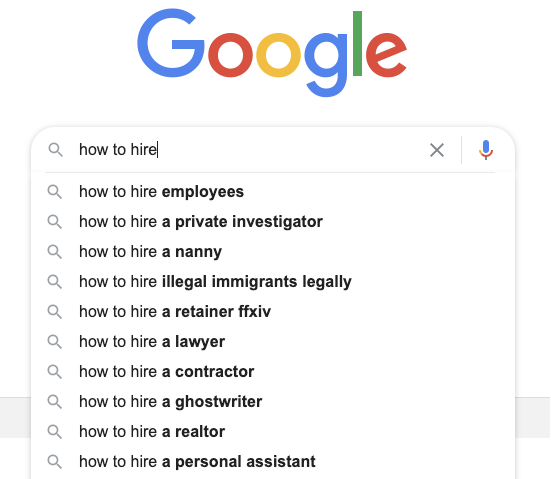
Keyword Research
If you have access to a keyword research tool, like Ahrefs that we use here at KlientBoost, then you can get a lot more data around what topics have organic demand and how competitive those terms are to rank for.
A great part of using Ahrefs is that they have a keyword research filter just for questions.
If you follow the steps in the screenshot you can quickly find which search queries have the most organic search demand. You can export these terms and create a content calendar to slowly start producing these posts.
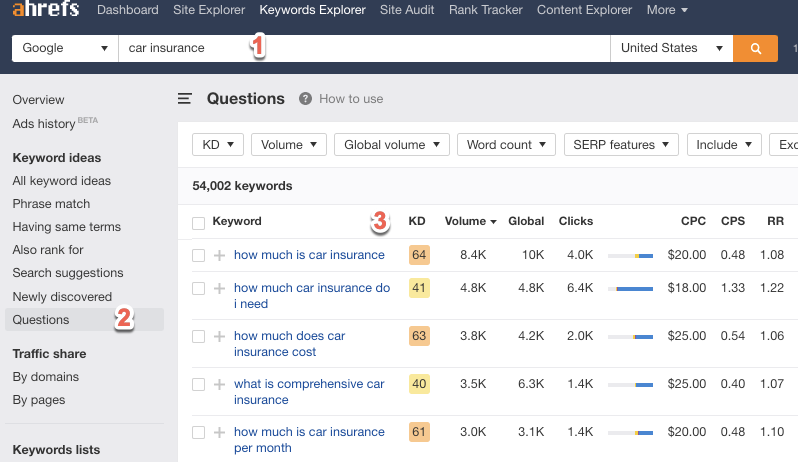
Quora Top Ranking Pages for Keyword [H3]
Another trick to finding great top of funnel content is to put websites like Quora or WikiHow into a tool like Ahref’s to find out if they are ranking for a lot of top-funnel terms in your industry. I like to use these two sites because they rank for a huge amount of terms across almost all industries and can usually be outranked by a brand in the space.
By putting these domains into an SEO tool, you can find what pages rank for the most keywords in your niche and the estimated traffic those pages get on a monthly basis.
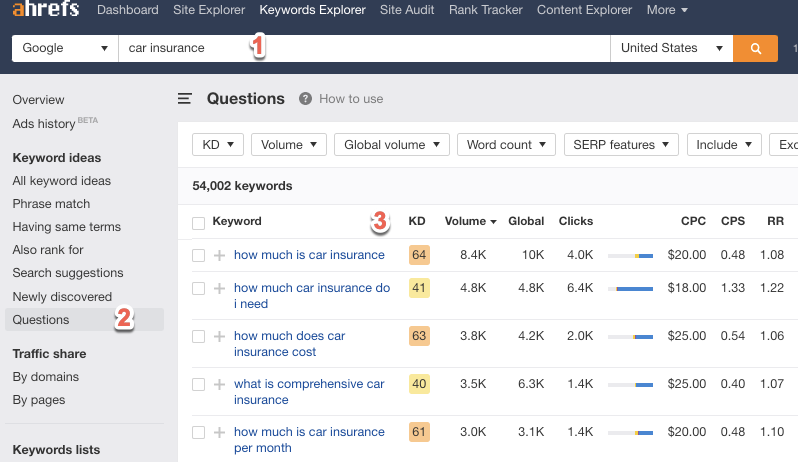
Top of Funnel Marketing Examples
Let’s see this tofu content in action. Here are some digital marketing examples of top of funnel content.
- How to Write a Google Review Without a Gmail Account – Signpost
- Why It Works: This is a great example because a lot of people who want to write a Google Review but do not know how, are business owners looking to respond to reviews of their business. These people are the ideal customers they want to sign up for a demo of their software.
- CTA: This post does a good job of having a Fast Lane CTA (Get A Demo) and also a Slow Lane CTA (Free Guide to Google Reviews).
- Repairing A Slab Leak – Restore My Pipes
- Why It Works: This blog post is a great example of creating a page that targets top of funnel content around “Signs of a Slab Leak Repair” and “What is a Slab Leak” but also tries to get people to call or contact them for service.
- CTA: This post does a good job of having a couple of Fast Lane CTA’s (Call Us Now) and another Fast Lane CTA (Contact Form).
- Gear Guide to Camping in a Truck – DECKED
- Why It Works: This is a great example of a topic of someone researching how to camp in their truck. They probably have never heard of DECKED before, but after reading this blog post on the advantages their product offers, they might purchase the product for their truck camping adventure.
- CTA: This post does well at getting people in the Fast Lane (sales funnel) by selecting their vehicle. They also include links to social platforms so readers can easily share this content with their friends on the social platform of their choosing.
- Facebook Ad Examples – KlientBoost
- Why It Works: This is a great topic for KlientBoost because we get to show off our skills of being a top-notch Facebook ads agency. People who are trying to do Facebook ads on their own often look for inspiration on what works best. When they see the quality of our work and read some of our Facebook Case Studies they are more likely to hire us to take over handling their social ads.
- CTA: On the KlientBoost blog we actually have three different calls to action that we leverage. First, we have an email capture where we can continue to build a relationship over time. The other main CTA is to have potential clients ask for a proposal which we do through site chat and buttons.
Make The Relationship Funnel-Official
If somebody slides into your DMs immediately after matching on a dating app and asks for your hand in marriage...you’re running for the hills.
Top of funnel content is of the utmost importance. I’d even go as far as saying that it’s underrated by marketers.
If you’re doing it wrong, you’re losing valuable contacts. The more people you’re bringing into your funnel, the more opportunity to get a bigger audience at the bottom of your funnel.
It should be given just as much importance as everything else.
By slowly getting acquainted with your audience and, most importantly, by providing value, you set your company up for long-term success and improved ROI across all marketing channels.
Now that you’re getting comfortable with the top of the funnel, you’re ready to learn everything there is to know about the bottom of the funnel.
But, with a full-funnel understanding, it’ll make way more sense why we actually think the funnel is broken ¯\_(ツ)_/¯ (and what to use instead). By then you’ll be a full-on expert, ready to speed up your growth, moving leads through the funnel-like it’s nobody’s business.
Let us know which tips help get your customers moving through the funnel or share any that you think we’re missing. We love to hear what you’re thinking.